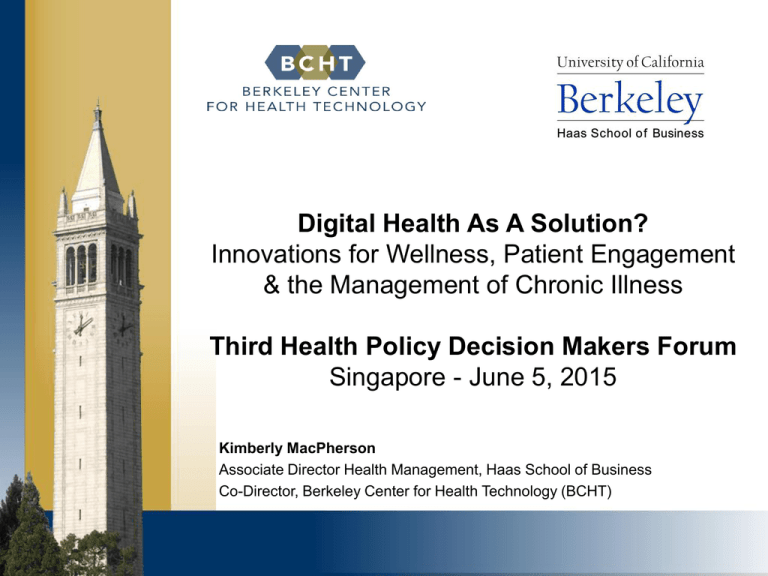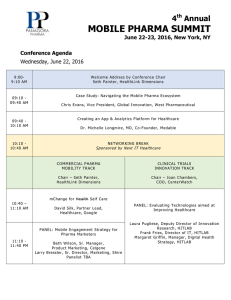Document 14554428
advertisement

Digital Health As A Solution? Innovations for Wellness, Patient Engagement & the Management of Chronic Illness Third Health Policy Decision Makers Forum Singapore - June 5, 2015 Kimberly MacPherson Associate Director Health Management, Haas School of Business Co-Director, Berkeley Center for Health Technology (BCHT) Overview What is Digital Health and what is driving its growth? How is Digital Health Having an Impact on Pharmaceutical Business Practices? New Players in the Space: What are Apple and Google Doing? Potential Challenges in realizing Full Promise of Digital Health Summary thoughts 2 Impetus for Digital Innovation in Heath Inefficient healthcare systems with many opportunities for improvement Current burden of chronic disease is enormous and projected to rise over time – huge opportunity Large populations High cost areas – immediate and downstream Quality of life issues Increasing cost sharing – have their attention Willingness to utilize technology and better access to data 3 Consumer Willingness to Manage Life via Technology Mobile phones and tablets are everyday part of life in US and globally Willing to use them to do many things, previously done face to face or over the phone Banking functions/transfer money Shop for consumer goods, services Communicate, connect, share personal updates/status Job search 4 Powerful Story for Entrepreneurs and Investors Surge of patients with chronic conditions – In IMS study, members < 65 with these conditions filled >75% of all prescriptions (9,237/11,776) Growth in utilization and cost trends globally – predicted $1.2T by 2016 17% of children and adolescents are obese – tripled from one generation ago; Over 68% adults are obese per CDC in 2012 High level of potentially avoidable costs $475B 5 New Firms Are Rapidly Creating Innovative Solutions Enhancing connection to health and health care though reminders, education, motivational support Improved and documented communication between patient and provider (and sometimes payer) across range of modalities Telephonic Email Web SMS/Text Medication tracking location, frequency, dosage, etc Remote sensors 6 Claim Digital Health Will Help Us….. Reduce medication errors and promote compliance and increase patient satisfaction Reduce activity in high cost areas: emergency department and admissions/readmissions Allow case managers/medical personnel to focus more time on the complex, multi-chronic patients as others learn to self-manage Contribute more information to patient records and databases/registries for analysis and predictive modeling Enhance access to rural and low income consumers, traditionally hard to reach with traditional forms of medical care and communication Potential for cost decrease with need for fewer expensive machines – adapt existing consumer technology to help support monitoring 7 Digital Health Firms are Following Opportunity and Incentives in Few Key Categories 8 Common Business Models Include Wearables and basic tracker/fitness applications are targeted at consumers; also simple chronic disease/smoking cessation, etc More sophisticated solutions are typically pitched at businesses who are perceived to have rationale to pay for the consumer/end user: health system, accountable care organization, health plan, employer Rationales include saving downstream cost in more expensive areas, generating better data, enhance productivity-preventing/reducing absenteeism/ 9 Enthusiasm and Promise High But Signs of Some Challenges Ahead Proving difficult to get funding after the early stages (Seed, Series A) Looking for results – are you achieving promised results/outcomes? Do you even know how to measure own impact? Often business models have been poorly defined – chasing solutions Many follow-on or “me-too offerings = some areas saturated (e.g. diabetes) Firms may have been overvalued at early stages 10 Pharma is Stepping Up to “Own the Disease” and Go “Beyond the Pill” Arthur D Little’s 2013 global pharma survey showed that 84% of those asked, felt it was crucial to have digital health strategy by 2020, 73% felt it would have crucial impact on competitive advantage 11 What Else Drives Pharmaceutical Companies to Engage with Connected Health? 12 Innovative Ways to Solve This & Other Challenges Facing Industry 13 How is Pharma Changing? Partnering to Create Data and Community Platforms PatientsLikeMe creates networks that support a range of diagnoses Patients in different conditions can connect with others experiencing the same symptoms and condition and track and share their own experiences. Over 325K members Members generate data about the real-world nature of the disease that can help researchers, pharmaceutical companies, regulators, providers, and nonprofits develop more effective products, services and care Starting with Genentech, PatientsLikeMe data/platform is now used (AstraZeneca just signed 5 year deal) in the R&D process – They can use the information to better understand what patients value Clinically effective isn’t enough if doesn’t fit patients’ wants/needs 14 How is Pharma Changing? Partnering to Create Data and Community Platforms Partnering on projects such as recent wearables trial with Biogen where they collaborated on a project to track the activity of people with MS Gave ~250 PatientsLikeMe members Fitbit One devices. Had 87% adherence Has implications for how the health of MS patients is assessed in clinical trials and healthcare with more mobility data. 15 How is Pharma Changing? Partnering to Facilitate Clinical Trials and Enhance Investment Opportunities Qualcomm Novartis for mobile enabled clinical trials program: “Trials for the Future” Roche has program around capturing data from connected devices (anticoagulation units 1st) Walgreens customers can use 2Net to synch certain mobile devices and send biometrics to their MDs Also around investment arms – Roche Ventures, Novartis & Qualcomm, Biogen & Google X 16 How is Pharma Changing? Working with Start-ups to Revolutionize How Medications Are Tracked Proteus Digital Health - FDA cleared (also has CE mark in EY) ingestible sensor and patch that provides digital feedback with 99.1% accuracy vs observation/self-report - $172M round of funding in summer 2014 (WSJ reported its latest valuation as $1.1B) Sensor also tracks other statistics including sleep and activity levels Customers have mainly been pharmaceutical companies who use the technology in trials to assess medication adherence as well as the effects of medication Patch transmits data from the ingestible sensor pill to the mobile device – no side effects reported to date 17 Other Established Medical Device, Fitness and Telecom Players Also Moving into Digital Health 18 Plus - What Will Apple & Google Do Next? 19 Ways Google is Moving into Digital Health Store your genome in the cloud for $25/year (Google Genomics) Google Glass applications for health care Partner with Novartis on contact lens that can detect glucose levels Trying to reverse aging (Calico) Developing nanoparticle capabilities that may Create a pill that will allow detection of cancer, heart disease very early on Facilitate creation of synthetic skin 20 What Is Missing? How To Make Digital Health “Sticky” and Have a Lasting Impact Clinical Evidence base – is the solution based on credible research base? Does firm have clinical trials data? Support Network – moving past wearables and simple reminders - live Coaching – may be critical Personalization & Gamification - is it a “fit” for individual’s needs/motivations at that time? How maintain momentum? Integration – how challenging will it be to work with the solution? Will it connect to existing systems and can important data be captured, used? Is it administratively complex? GOAL: scale/adoption/persistency – will sufficient numbers of providers and patients use it and will it be used long enough and consistently enough to make a difference? 21 Digital Health holds great promise but has to refocus on key areas: Better business models that target and solve real problems for those being asked to pay Better evidence of clinical efficacy and linkage to actionable data Better motivational underpinnings to truly engage patients for the longer term Questions? 22









